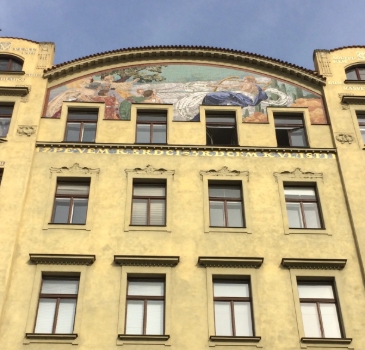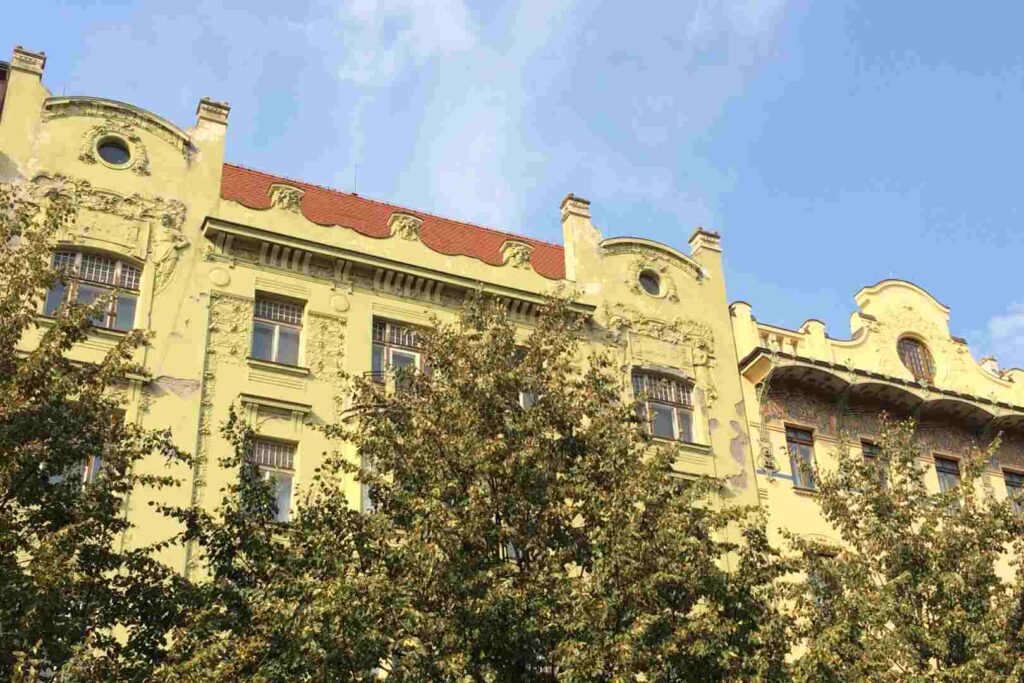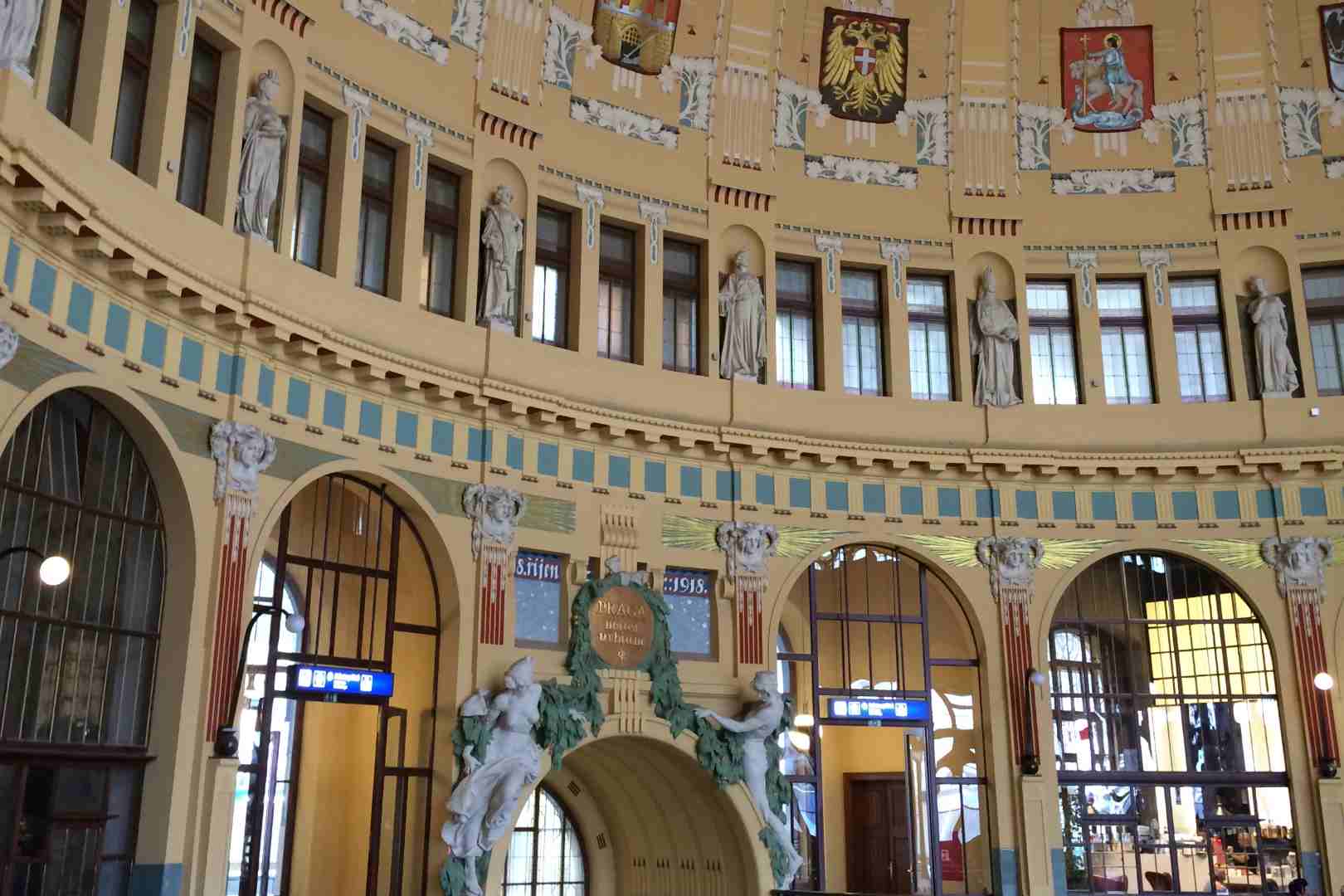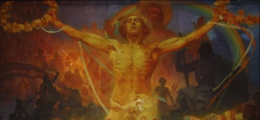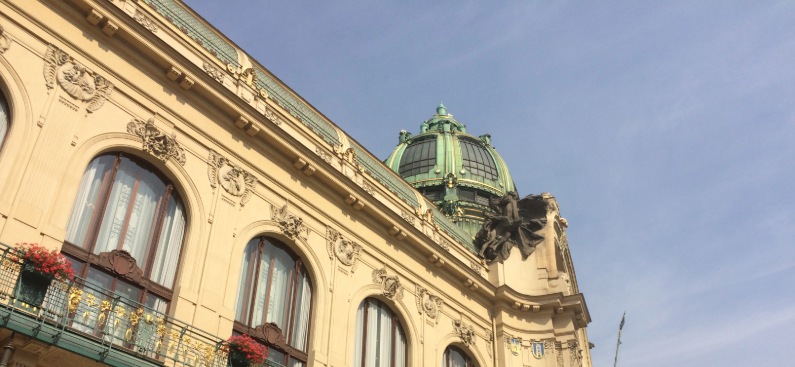Prague is often seen as a global hub for Art Nouveau, though it’s common for people to confuse it with the Secessionist style at first glance. A key way to distinguish Prague’s Art Nouveau architecture is by spotting the organic decorative elements that adorn the exteriors. You’ll often find motifs inspired by nature—trees, flowers, vines, and fruits like apples, pears, and grapes. In early examples from around 1900 to 1905, these details might be subtle, but by 1912, the style evolved, with decorative features becoming structural, such as balcony supports. While Art Nouveau originated in Belgium and gained popularity in Paris, Bohemia was slower to embrace it. However, thanks to Prague’s preservation during World War II, the city has now emerged as one of the most important centers for this architectural movement.
Prague is rich in Art Nouveau architecture, and while you can find examples scattered throughout various districts, three areas in particular stand out: Vinohrady, Ujezd, and the Jewish Quarter. These distinct neighborhoods, though different in character, share a historical connection that traces back to the year 1887.
That year marked the beginning of major urban redevelopment, including the eventual destruction of the old Jewish Ghetto. Simultaneously, the city expanded into two key areas: Vinohrady, located to the east of the National Museum, and Ujezd/Smichov, situated along the riverbank just south of Mala Strana. These districts were largely developed from scratch, and since Art Nouveau was the prevailing architectural trend at the time, many of the buildings erected in these areas followed that style. The demolition of the Jewish Quarter, which spanned two decades and ended in 1908, saw many of the new constructions in the area also embrace the Art Nouveau aesthetic. While both Vienna and Prague once boasted extensive Art Nouveau architecture, much of Vienna’s was lost during World War II, leaving Prague as one of the best-preserved examples of the style.
Art Nouveau in Prague, like Baroque, is considered a “Total” art form. It extends beyond architecture to encompass interior design, decorative arts, fine arts, graphic art, furniture, jewelry, and glasswork—everything except music. When exploring a purpose-built Art Nouveau building in Prague, the first thing you’ll notice is an ornate entranceway, often leading to a grand stone staircase with intricately designed wrought-iron railings, sometimes complemented by wall mosaics. Inside, apartments typically feature plain but elegant doors, parket flooring, high ceilings, and colored glass fixtures. French windows often open onto balconies with wrought-iron railings, offering a touch of elegance. Apartments in Vinohrady, in particular, are highly coveted for their architectural charm, with residents frequently investing in original or reproduction Art Nouveau furnishings to maintain the building’s historical integrity.
To explore Art Nouveau architecture in Prague, a great starting point is Paris Street, where nearly every building was constructed between 1902 and 1907. For a glimpse into stunning interiors, I highly recommend taking a guided tour of the Municipal House. Although it opened in 1912, toward the end of the Art Nouveau period, the building is a masterpiece in its own right. If you prefer not to join a tour, at least step into the ground-floor café to soak in the intricate design. Another favorite of mine is Cafe Louvre, a reconstructed Art Nouveau gem in the New Town. You can read more about it on my Cafes page. For those who enjoy walking tours, the Old Town and Jewish Quarter are filled with Art Nouveau architecture, offering a visual feast of this elegant style.
After dedicating plenty of time to researching, exploring, and showcasing the architectural richness of Prague, we decided to introduce a specialized tour, similar to what we’ve offered in cities like Vienna and Budapest. This tour is tailored for those who wish to gain a deeper understanding of the architectural and artistic transformation that shaped Prague’s city center. Focusing on the period from the late 19th century to the early 20th century, particularly between 1894 and 1914, when Art Nouveau flourished, the tour offers insights into the unique design elements and cultural influences that defined this fascinating era in Prague’s history.
A visionary beyond aesthetics, Mucha used his art to convey messages of unity and heritage. His monumental “Slavic Epic” stands as a testament to his dedication. Learn more about his cultural contributions here.
We have different private tours in Prague, that can be found HERE. For example, we had a 3-hour private tour in Prague that has helped many visitors understand the Czech capital’s.
We also offer a comprehensive 8 hour private tour showing the most beautiful buildings and works of art associated with the Art Nouveau movement in the city of Prague. If you decide to book this private tour, we will introduce you the beauty of this style which marked significantly the architecture of the Czech capital in the turn of 19th and 20th century. A part of the private tour will be made by car or minivan which will allow you to enjoy the full and see as many highlights as possible.
The main difference between our 3-hour and 8-hour private tours in Prague is the level of depth and range of experiences. The 3-hour tour offers a concise yet immersive introduction to the key Art Nouveau highlights, focusing on select landmarks and their historical significance. It’s perfect for those with limited time but who still want a rich understanding of Prague’s architectural gems.
In contrast, the 8-hour tour provides a comprehensive exploration, covering multiple neighborhoods, more detailed discussions on Prague’s architectural evolution, and the opportunity to visit both interior and exterior spaces at a relaxed pace. You’ll have time to explore iconic buildings, cafes, and hidden treasures across the city.
We can also adjust the tour duration to suit your preferences, offering flexibility for a customized experience. Whether you want something shorter or longer, feel free to contact us at contact@artnouveau.club, and we’ll tailor the tour to your needs.
Beyond Mucha: Exploring the Diverse Art Nouveau Heritage of Prague
Prague’s Art Nouveau scene is often closely associated with the famous artist Alphonse Mucha, known for his iconic posters and decorative art. However, the city’s Art Nouveau movement extends far beyond Mucha’s influential work. While his contributions are undeniably significant, there are numerous other artists, architects, and designers who played pivotal roles in shaping the Art Nouveau landscape of Prague.
The city is adorned with stunning buildings and interiors showcasing a variety of styles and motifs characteristic of the Art Nouveau period. From the intricate facades of the Municipal House to the elegant designs found in Vinohrady and the Jewish Quarter, Prague’s architecture reflects a rich tapestry of artistic innovation.
Today, Mucha’s art is loved for its portrayal of feminine power and grace, with each figure embodying a unique presence. For insights on his celebrated style, read more here.
Many lesser-known artists and architects, such as Otto Wagner and Josef Hoffmann, also made significant contributions to the movement, blending functionality with ornate aesthetics. Exploring Prague’s Art Nouveau is a journey through a diverse range of influences, styles, and artistic expressions that collectively define this remarkable period. So, while Mucha is a central figure in the narrative of Art Nouveau in Prague, there is a wealth of artistry waiting to be discovered beyond his iconic imagery.
